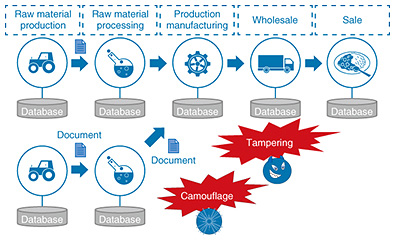 |
|||||||||||||||
|
|
|||||||||||||||
|
Global Standardization Activities Vol. 16, No. 5, pp. 40–44, May 2018. https://doi.org/10.53829/ntr201805gls Trends in Standardization of Blockchain Technology by ISO/TC 307AbstractThe second meeting of ISO/TC 307 (International Organization for Standardization Technical Committee 307: blockchain and electronic distributed ledger technologies) was held in Tokyo in November 2017. This TC is working to develop international standards for blockchain technology. This article introduces the concept of blockchain technology—the fundamental technology used for bitcoin—as well as trends in the international standardization of electronic distributed ledger technologies and some applications of blockchain technology beyond cryptocurrency. Keywords: blockchain, distributed ledger, traceability 1. IntroductionIn April 2016, Australia proposed to the International Organization for Standardization (ISO) to set up a technical committee (TC) on standardization of blockchain technology, which was in the spotlight as the fundamental technology of cryptocurrency, as represented by bitcoin. In September 2016, a TC on blockchain and electronic distributed ledger technologies was established (TC 307), and international standardization efforts began in the areas of blockchain and electronic distributed ledger systems and application, interoperability, and data exchange between users. The second meeting* was held in Tokyo in November 2017, following the first meeting held in Sydney in April 2017. In line with international standardization efforts on blockchain technology, a domestic committee for making proposals to ISO/TC 307 was established, and JIPDEC (Japan Institute for Promotion of Digital Economy and Community) [1] took on the role of secretariat of the committee. Many Japanese organizations and companies involved with blockchain technology participated and began making recommendations. NTT and NTT DATA are the NTT Group companies participating in the domestic committee.
2. Standardizing the concept of blockchainBlockchain technology is often mentioned, but it is not easy to explain it clearly in a short and simple phrase. The reason for this is that it simply is an unconventional concept. It is most commonly explained as a noncentralized ledger in a network system. The Ministry of Economy, Trade and Industry and the Financial Services Agency of Japan use the expression distributed electronic ledger to explain blockchain technology. A blockchain collects a certain amount of data as a block and has a data structure connected like a chain (Fig. 1). The context of blocks forming the chain is defined using cryptographic technology. A blockchain is equivalent to a data store that takes the role of a ledger in a network system consisting of several nodes. There are many different ways for a data store to take on the role of a ledger in a network system, but the blockchain has a unique feature in terms of structure. It may be imagined that each node in a network possesses part of the ledger, and the nodes together form a ledger as an entire system (hence the idea of a distributed ledger).
In fact, though, the parts of the blockchain (ledger) that each node possesses are all the same, and thus, each node possesses a complete ledger where all transactions are recorded. The word distributed is used because even though there are no nodes with a centralized role in the network, the network that uses a blockchain is designed to autonomously maintain the blockchain. The point is, what is distributed is not data, but authority. Moreover, the mechanism for forming and maintaining the blockchain is typically called blockchain technology [2]. The international standardization efforts for blockchain technology in ISO/TC307 are being carried out in order to standardize the blockchain concept and the mechanism to support it. 3. Blockchain technology spread by standardizationA representative theme of blockchain is its use in cryptocurrency. A mechanism applying bitcoin and altocoin is being studied. Meanwhile, other uses of blockchain technology outside the area of cryptocurrency are now being studied, notably traceability and digital identity. These uses have the following characteristics:
Various obstacles arise when an information system used by a specific organization needs to connect to another organization’s information system. Examples of such obstacles include the connection method and the emergency response method. Therefore, in some cases, paper-based work is done when connecting to another organization. Also, there may be cases in which documents are acquired from another organization in paper form and then have to be input to the acquiring organization’s information system. These are things to consider when looking at possibilities for using the blockchain to perform tasks currently being handled using the existing system. 4. Effects of blockchain when applied to traceabilityHere, we explain the expected effects of applying blockchain to traceability. The example described here involves the case of a problem occurring in a product component. An investigation of such a problem would typically require a lot of time and effort to find when the component was made, which organization provided it, what type of product the component was used in, and other details. Moreover, the possibility of data tampering and/or data disappearance may need to be considered (Fig. 2).
A distributed ledger—the key blockchain feature—is premised on sharing information between platform participants, recording transaction information in chronological order, and easily implementing the technologies for performing these functions. New participants can easily join and leave the blockchain because it is based on the premise that information is shared between participants. When problems occur, an investigation can easily be done by tracing the data structure because the data are managed in chronological order. Also, many different types of blockchain technologies can be easily used because mechanisms to access them via smartphones as well as via a web browser are provided (Fig. 3).
Prompt transactions can be carried out, even with transactions that would conventionally be paper based, as information can be shared with the other organization through the blockchain by operating on a conventional computer screen. The possibility of shortening the operating time in international trade transactions has been reported [3]. 5. Future perspectivesThis article explored the application of blockchain technology to traceability. Although positive effects can be expected in such applications, such effects may be limited because blockchain technology is still in a growth stage. Research and development of higher uses of blockchain is necessary in order to advance the technology. For instance, the following points require further research:
A research network for blockchain technology called BSafe.network [5] and an industry-academia cooperation organization called BASE Alliance [6] have been established. The focus on blockchain has thus spread to the academic sector as well. In addition to technological development, efforts to establish legal systems and rules on system procurement by the government are also important. At the keynote speech in the opening ceremony of the Tokyo meeting, a representative from the Ministry of Economy, Trade and Industry reported on some government-leading projects as advanced use cases, including a demonstration project involving a land registry in Sweden, and a policy to create venture companies related to blockchain that was triggered by electronic governmentization (e-governmentization) efforts in Estonia. Blockchain is certainly spreading from the elemental technology of cryptocurrency to other technology applications that use the distributed ledger. A world where the blockchain is used in an invisible part of the services that we use is not that far away. References
|
|||||||||||||||














